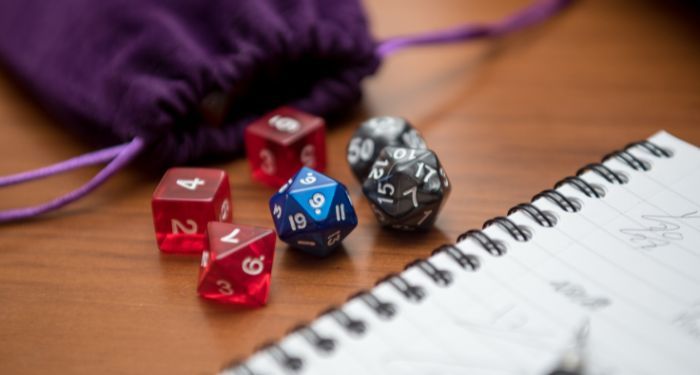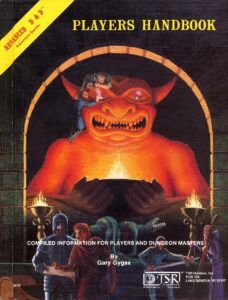Before D&D was the game as we know it, it grew out of a medieval war game called Chainmail. The game was built to simulate medieval combat, but there was a 14-page supplement included at the end of the game that explained how to apply the rules to a fantasy setting. When Dungeons & Dragons was first published, the game came in the form of three booklets in a woodgrain-colored cardboard box: Men & Magic, Monsters & Treasure, and Underworld & Wilderness Adventures. The first print run was of 1,000 hand-assembled copies, and it sold out in less than a year. D&D is set in a medieval fantasy world in which players form a group made of different races and classes. They are led through the story by a Dungeon Master who narrates their adventure. Players determine how to respond to the events in the game, and the success of their actions are determined by rolling dice. The dice are 4-, 6-, 8-, 10-, 12-sided, but many of the choices in the game are decided by the 20-sided die. Each player’s character’s class, race, strengths, and weaknesses can also play into the success of their actions. In the original D&D boxed set, there were only three main classes a character could play: Cleric, Fighting-Man, or Magic-User. As for races, players could be a human, elf, dwarf, or hobbit (later renamed halfling). In 1977, Dungeons & Dragons divided into basic and advanced versions of the game. The Monster Manual was the first book in the Advanced Dungeons & Dragons product line, introducing 350 different monsters into gameplay. A year later in 1978, a 128-page hardcover called The Players Handbook further expanded the world of Advanced D&D. Finally, in 1979, TSR released the Dungeon Masters Guide, the third and final core Advanced Dungeons & Dragons hardcover rulebook. TSR published Dungeons & Dragons content until 1997, when Wizards of the Coast purchased the company and after three years of development released Dungeons & Dragons 3rd edition in 2000. In the biggest revision of D&D rules to date, this new edition of the game combined the Basic and Advanced D&D games into one unified game. The new edition also allowed players to customize their characters in unique ways, introducing skills and feats into character creation. Based on feedback received from D&D players on the 3rd edition, Wizards of the Coast released a 4th edition in 2005. Then in 2012, Wizards of the Coast announced that they would be developing a 5th edition, using further suggestions from players and letting them playtest the rules. Public playtesting began in May 2012, and the 5th edition was finally released in 2014, to coincide with the 40th anniversary of the game. Early in Dungeons & Dragon’s publication history, it became clear that the game was inspired in no small part by the fantasy world of Lord of the Rings. In fact, early versions of the game were so similar to the LOTR world that the Tolkien estate hit Gygax and Arneson with a lawsuit that was eventually settled out of court. According to Gygax in a post on EN World, the Tolkien estate wanted the words dragon, dwarf, elf, ent, goblin, hobbit, orc, and warg removed from the game entirely. While it was successfully argued that most of the fantasy names belonged to the public domain, D&D was required to change hobbits into halflings, ents into treants, and balrogs into balor. Throughout the game’s years of popularity, the game has also been accused of promoting Satanism and witchcraft. This Satanic Panic peaked in the 1980s, with religious groups publishing anti-D&D tracts that showed the RPG to be a slippery slope into demonic worship, murder, suicide, and more. D&D has also been accused of portraying negative racial stereotypes through its description of fantasy races such as orcs and “dark elves” as inherently brutish and evil characters. The creators of D&D are still grappling with this issue, and a lot of it comes down to individual character choices and gameplay; however, in 2020, the D&D team announced that they “would be making changes to portions of its 5th edition product line that fans have called out for being insensitive…The company will also be making a substantive change to character creation to broaden the permissible spectrum of character types within each of the game’s many races.” To coincide with the 50th anniversary of the popular role-playing game, Wizards of the Coast has announced that the game will receive a “major update” in 2024. The announcement was mad at the “Future of D&D” panel at D&D Celebration 2021, and at the end of August, Wizards of the Coast released more details about what we can expect from that update. That update is officially called One D&D, which is the “codename for the future of D&D.” This update will include a major update and expansion of the rules of the game, including updated versions of the Monster Manual, Dungeon Master’s Guide, and Player’s Handbook. The D&D Beyond website will also see a major overhaul, with new tools and resources for D&D players. Finally, Wizards of the Coast will be introducing a new digital D&D play experience. One D&D is currently in the playtesting phase, but there are certainly lots of exciting things to come for D&D fans! For further reading about the history of Dungeons & Dragons, be sure to check out Slaying the Dragon: A Secret History of Dungeons & Dragons by Ben Riggs, which was published earlier this year. Looking for more D&D content? Here’s why you should start a Dungeons & Dragons club at your library. And here are the books you should read based on your D&D class.

